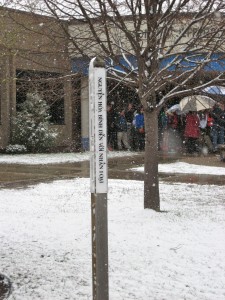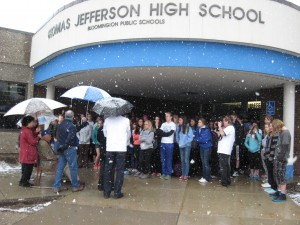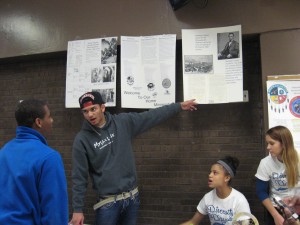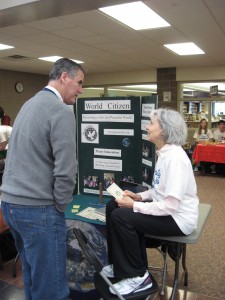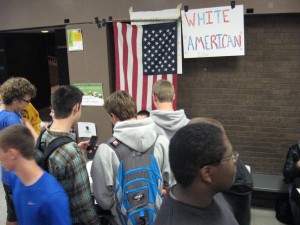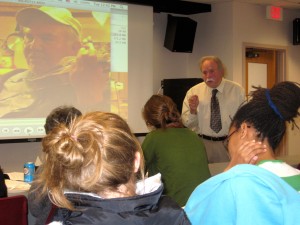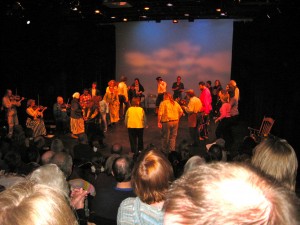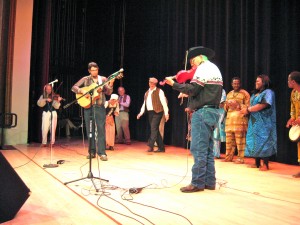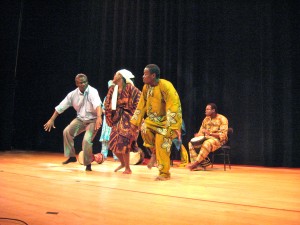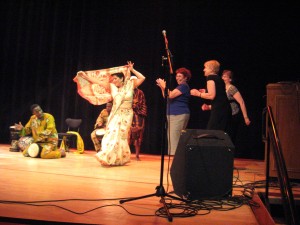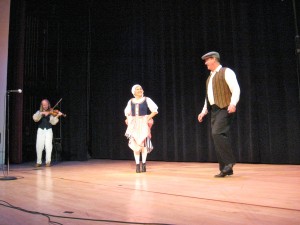#714 – Dick Bernard: The Youngers restore my hope.
Today was the 10th annual Diversity Day at Jefferson High School in Bloomington MN. I’ve been to the last six. Today did not have the annual outdoor fun-run between Jefferson and rival Kennedy due to inclement weather. Snow in May is not impossible here, but it is unusual. It was unpleasant enough to force most activities indoors, but not enough to dampen spirits.
Being in the presence of enthusiastic kids is like an elixir.
It is nice to see a society of kids at their functional best.
(click on all photos to enlarge)
Inside, there was an alternative run around Jefferson’s ample indoor track. Everyone could participate. You can see my the smile on the young lady’s face, that she was glad she could make the rounds with the rest of the students who wished.
Out in the commons area, 42 student groups sponsored and staffed tables about their particular special interest. Damon Cermak (below) did a more than capable job of representing his Mdewakanton Sioux Indian heritage. Like most young Americans Damon has multiple ethnic heritages. His include Czech and French-Canadian, along with Native American.
Down the commons, another group of students were doing some kind of dance improv, and having a great time, a real credit to their school.
Walking around I came across a table I had not seen in previous years.
The table was staffed by a couple of boys, and attracted a fair amount of interest from, as best as I could tell, only other boys who were curious. It was a simple table: an NRA hat, some pictures like Iwo Jima and Ronald Reagan, that sort of thing.
One of the boys had a guitar.
There was a certain irony in this new entry into this years Diversity Days conversation, I thought. Best as I could determine, the table was by and about White American Men, or at least a subset of those men who are angry and terrified of losing control to various “others”, like “minorities”, or “women” or such.
White American Men (I’m one of these) have controlled things so long, that it is hard for some of them to become part of the entire fabric that is contemporary America. This year at Jefferson they seem to have joined the other “minorities” that make up the rich American “stew” – though my guess is they didn’t perceive their new position that way.
But that “White American” table, along with the others representing other cultures and beliefs, was totally in keeping with the rich diversity that is America. White American Men are part of, not dominant over, the rest.
Before leaving I decided to go to the all-school assembly program for Diversity Day.
The speaker was Jane Elliott, 58 years married, wearing a T-shirt she says she always wears while speaking “Prejudice is an emotional commitment to ignorance.”
She’s very well known, for many years, and is a spell-binding and powerful speaker. The assassination of Martin Luther King April 4, 1968, changed her life as a third grade teacher.
A tall white man, school administrator, and a female student of African descent were her “props”, and she used them extremely effectively.
In only a few minutes she powerfully took on and effectively many stereotypes and prejudices we hold dear.
Walking out the door to the parking lot I went past the Peace Pole I had photographed earlier in the day.
The side I photo’ed had “May Peace Prevail on Earth” in Vietnamese.
It all seemed to fit.
Just a couple of days earlier, my friend Lynn Elling, who had earlier talked at the rededication at Jefferson, had returned from a two week trip to Vietnam with the Vietnamese son, Tod, who the Ellings adopted 43 years ago.
Tod is as American as any of us.
Diversity is all of us.
